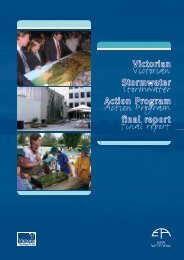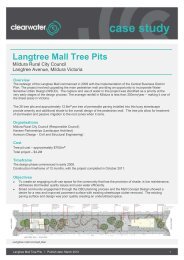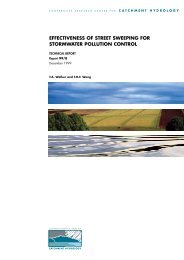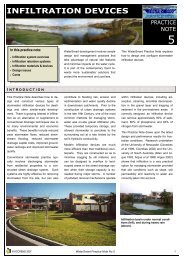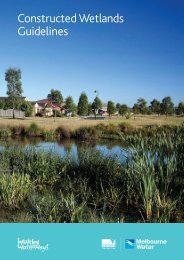Hydraulic performance of biofilter systems for stormwater management
Hydraulic performance of biofilter systems for stormwater management
Hydraulic performance of biofilter systems for stormwater management
Create successful ePaper yourself
Turn your PDF publications into a flip-book with our unique Google optimized e-Paper software.
change occurs over time. Two hypotheses could explain this phenomenon: on one hand<br />
sediment depositions could be leading to the clogging <strong>of</strong> the surface <strong>of</strong> the system;<br />
another possibility is that the creation <strong>of</strong> macropores through root growth and dieback<br />
may help to minimise the reduction in K. The impact <strong>of</strong> surface clogging is<br />
proportionally greater in <strong>systems</strong> which started with a high initial K, most likely<br />
because the difference in particle size distribution between the original filter media and<br />
deposited sediments will be greater where the original media was coarse. In the <strong>systems</strong><br />
with low initial K, the finer particle size distribution will be more similar to that <strong>of</strong> the<br />
inflow sediments (although still considerably larger), thus reducing the proportional<br />
impact <strong>of</strong> any surface clogging effect.<br />
Site characteristics such as filter area as a proportion <strong>of</strong> catchment area, age <strong>of</strong><br />
the system and inflow volume were not found to be useful predictors <strong>of</strong> media<br />
conductivity, with initial conductivity <strong>of</strong> the original media explaining the vast majority<br />
<strong>of</strong> variance. It is clear there<strong>for</strong>e, that strict attention must be paid to the specification <strong>of</strong><br />
original filter media, to ensure that it satisfies current design requirements. Media<br />
should be tested after construction <strong>of</strong> the system.<br />
Given the apparent difficult in specifying and maintaining hydraulic conductivity<br />
in bi<strong>of</strong>iltration media, one approach is to use a “contingency factor” in the specification<br />
<strong>of</strong> hydraulic conductivity <strong>for</strong> bi<strong>of</strong>iltration <strong>systems</strong>. For example, where the design<br />
intent is to use a soil media with a hydraulic conductivity <strong>of</strong> 180 mm/hr, sizing <strong>of</strong> the<br />
system should be undertaken assuming a hydraulic conductivity <strong>of</strong> 50% <strong>of</strong> the design<br />
value (ie. 90 mm/hr). In this way, if the media does not meet specifications, or shows a<br />
decline in hydraulic conductivity over time, the overall system <strong>per<strong>for</strong>mance</strong> will remain<br />
satisfactory.<br />
Key words: Bi<strong>of</strong>ilters, clogging, <strong>stormwater</strong> <strong>management</strong>, hydraulic conductivity<br />
4




